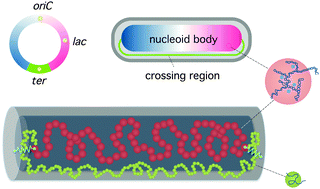Chromosome-like organization of an asymmetrical ring polymer confined in a cylindrical space
Abstract
To what extent does a confined polymer show chromosome-like organization? Using molecular dynamics simulations, we study a model Escherichia coli (E. coli) chromosome: an asymmetrical ring polymer, formed by small monomers on one side and big monomers on the other confined in a concentric-shell or simple cylinder with closed ends. The ring polymer is organized in the way observed for the E. coli chromosome: if the big monomers are assumed to be localized in the inner cylinder, the two “subchains” forming the ring are spontaneously partitioned in a parallel orientation with the “body” (big-monomer) chain linearly organized with a desired precision and the crossing (small-monomer) chain residing preferentially in the peripheral region. Furthermore, we show that the introduction of a “fluctuating boundary” between the two subchains leads to a double-peak distribution of ter-proximate loci, as seen in experiments, which would otherwise remain single-peaked. In a simple cylinder, however, a chromosome-like organization of the ring polymer typically requires an external mechanism such as cell-wall attachment. Finally, our results clarify to what degree the spatial organization of the chromosomes can be accomplished solely by ring asymmetry and anisotropic confinement.



 Please wait while we load your content...
Please wait while we load your content...